The trades sector and construction industry has traditionally been almost entirely male dominated, but things are beginning to change – and our research shows consumers want more of it.
We’ve analyzed online search trends, official government data and conducted our own research to gauge consumer sentiment around the growing demand for tradeswomen.
The number of consumers searching specifically for tradeswomen is rising
The number of homeowners searching for female tradespeople has increased significantly over the past few years.
Many related Google search queries have seen dramatic increases in volume. For example; ‘lady plumber near me’ (+450%), ‘lady painter and decorator near me’ (+125%) and ‘female carpenter near me’ (+100%) have all seen triple digit year on year percentage growth in the number of homeowners searching for them.
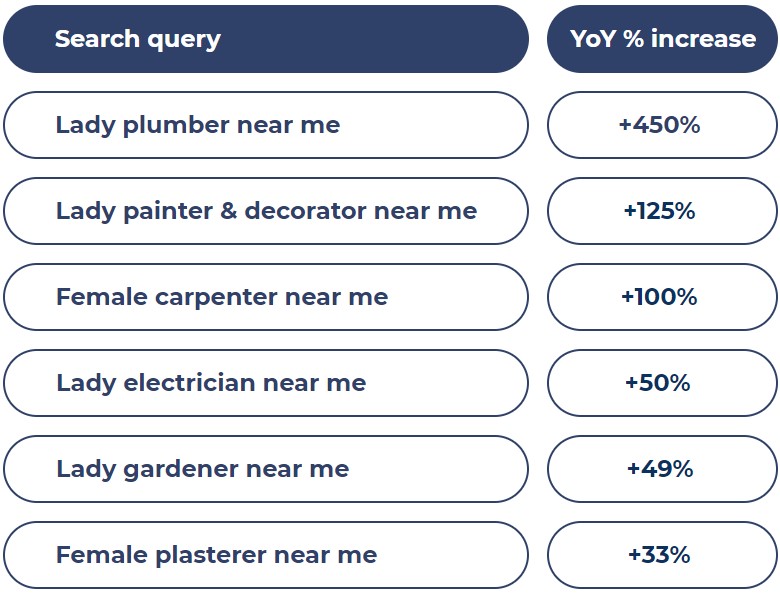
What’s the current landscape for tradeswomen?
Only 4% of the overall trades industry is made up of women
4% of tradespeople are female. However this statistic is actually skewed by one particular trade – gardeners and landscapers. Excluding gardeners and landscapers it falls to 2%.
Gardeners & landscapers and painters & decorators are the trades with the highest representation of women
The trade with by far the largest percentage of women is gardeners & landscapers at 17%, followed by some distance with painters & decorators at 4%.
Bricklayers, roofers and tilers have the lowest representation of women
According to ONS data, there are less than 500 female bricklayers, roofers and tilers respectively across the UK. This is less than 1% for each trade.
Tradeswomen are paid 10% less than men
Based on ONS data for full time employee jobs, women within the skilled construction and building trades sector were paid £536 per week in 2022 compared to £600 for men. Based on this statistic, females earn 10.6% less than their male counterparts or £64 per week less.
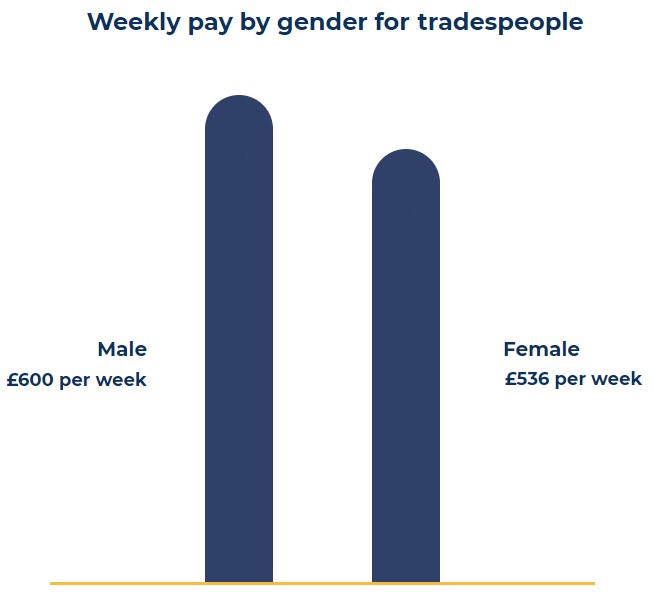
The West Midlands has the highest representation of tradeswomen
The three regions with the highest representation of tradeswomen are the West Midlands (where 4.40% of tradespeople are female), London (2.98%) and the South West (2.14%).
In many regions, less than 1% of tradespeople are women
In the East Midlands, North East, Northern Ireland, Scotland, South East and Wales, less than 1% of tradespeople are female.
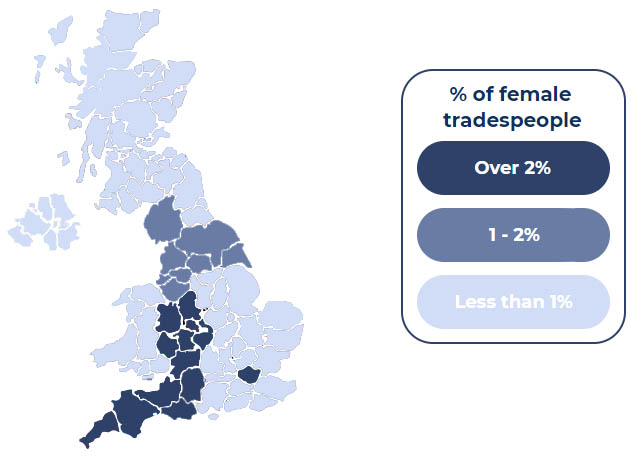
What’s the view from homeowners?
We conducted our own survey of homeowners that have used My Local Toolbox. The survey had 348 respondents, let’s look at the results.
11% of female homeowners would prefer to hire a tradeswoman
To expand on this statistic, amongst open comments in our survey of homeowners, there is a slight bias among females that suggests they’d feel more comfortable hiring a female tradesperson. Comments from our survey of homeowners, such as ‘I’d feel more comfortable hiring a woman’ and ‘I’d feel safer hiring a female tradesperson’, highlight this sentiment.
26% of homeowners have hired a female tradesperson before
Hiring a tradeswoman is becoming more common, with 26% of respondents to our survey indicating that they have hired a tradeswoman before.
96% of homeowners say they’d be willing to hire a female tradesperson
Almost all (96%) of the respondents to our survey indicated they’d be happy to hire a tradeswoman.
What does the future look like for tradeswomen?
Apprenticeship enrolment shows increasing demand from women
Between 2017 and 2022, the number of women starting construction related apprenticeships each year has increased from 1,060 to 1,770. The general trend is upwards but not every year has seen an increase on the last; out of the last 5 years, 3 have seen an increase and two a slight decrease on previous years.
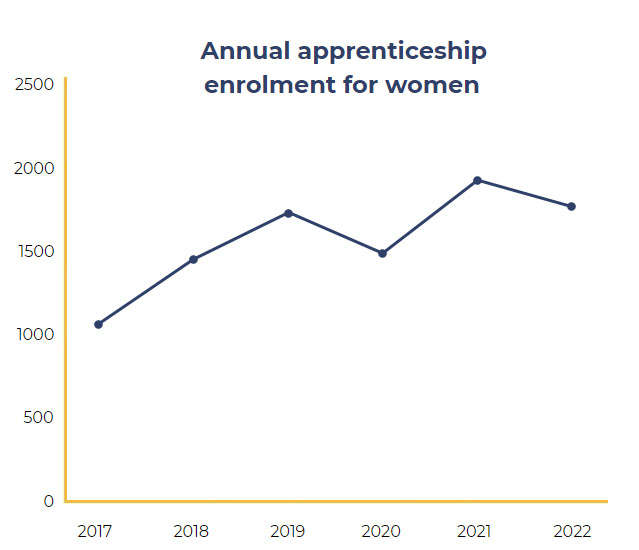
View from female tradespeople
We interviewed a variety of tradeswomen across the UK to gain an insight into their experience working in a predominantly male industry.
Eliza Tay lady decorators
Annette Taylor started her journey as a decorator 8 years ago. She runs Eliza Tay lady decorators in Plymouth and is a big advocate of promoting the trade to females.

What do you find most rewarding about being a tradeswoman?
“It is very satisfying to be able to say that we are doing this trade. A lot of people are shocked when they see us, or find out what we do as we are all quite feminine, but I actually think this literally gives the job a feminine touch!”
What challenges have you faced in your role?
“Not many really, our customers love us, and always say they prefer the female trades as we are much quieter, tidier, and more fun to have around!”
Do you believe being female provides you with any advantages over your competitors?
“Yes – we are mostly chosen because we are females, and we also get a lot of customers who may feel a bit vulnerable choose us too.”
Would you recommend other women to pursue a career in the trades industry?
“100%. In fact I promote it by always having at least one apprentice on my team (currently I have two). In total I have had 11 apprentices train with my company.”
Handywoman Lindsey
Handywoman Lindsey, a former engineer turned handywoman has been carrying out handywork for her customers for 11 years. Her skills cover a range of trades including tiling, decorating and carpentry amongst others.
What motivated you to pursue a career in this trade?
“I’ve always been good with my hands and enjoy building and making things, so doing something I enjoy while being paid for it is a win-win.”
How did you enter the industry?
“I worked in engineering after leaving school and then had kids. Being self employed was a lot easier juggling home life and only having myself to answer to.”
Do you believe being female provides you with any advantages over your competitors?
“Yes I do. Being a female in a male orientated profession is unusual. I get lots of work because most of my customers prefer a woman.”
Could you share any advice for women just starting their careers in the trades industry?
“Be organised and always keep the customer informed on start dates and prices. Be reliable. It’s amazing how many customers moan about other trades not offering these key things.”
Plumbing Bird
After a 15 year career in veterinary, Hannah Lewis wanted a new challenge in her life and so began training to become a plumber. In 2009 she created her own business, Plumbing Bird, which is still operating today.
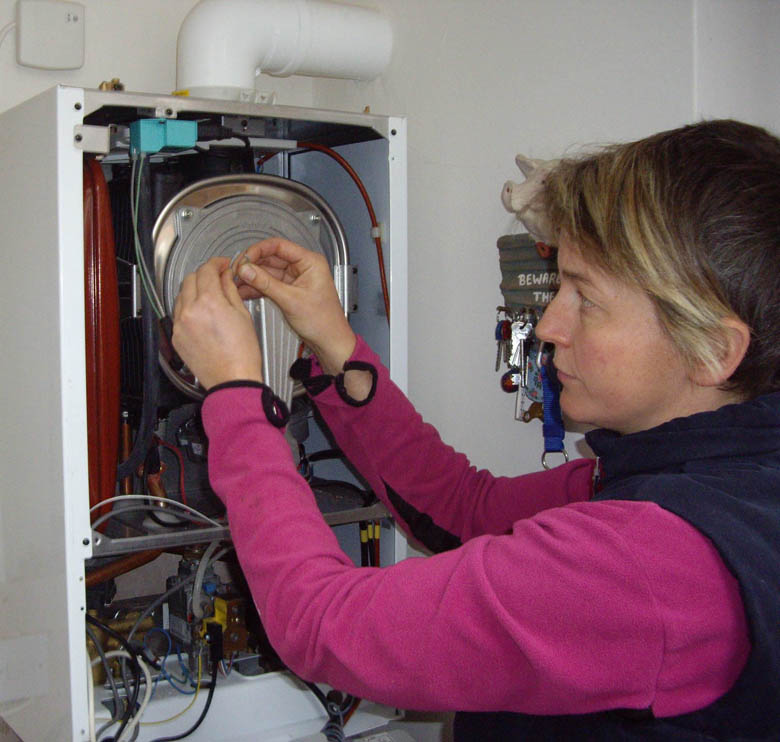
Do you believe that being female provides you with any advantages over your competitors?
“Yes. Because I’m very unique!”
What do you find most rewarding about being a tradeswoman?
“Building up relationships with my regular/loyal customers, some of whom I can call my friends after many years.”
Would you recommend other women to pursue a career in the trades industry?
“Yes, there are many avenues within different trades making it possible for women to pursue in certain areas and enjoy a successful career.”
Could you share any advice for women just starting their careers in the trades industry?
“It may seem daunting to begin with but if you enjoyed learning the theory and practical workshops of the trade throughout college and did well compared with your male peers, there’s nothing holding you back! You will gain valuable experience through making mistakes, but this is part of getting it right and becoming an expert. As long as you come back and remedy ongoing problems, your customers will appreciate your work and honesty.”
View from the founder of My Local Toolbox
“It’s fantastic to see the number of women interested in trades and construction increasing and stereotypes being challenged.”
“From a consumer perspective, the current increase in interest for tradeswomen will only continue to grow. The number of search queries relating to homeowners looking to hire female tradespeople will no doubt be much higher in the future.”
“It’s likely that we’ll reach a tipping point and see the rate of growth for these types of search queries increase dramatically. Currently, many homeowners wouldn’t think to search for a female tradesperson even if they’d prefer to hire one. Over time this could change, as more women enter the sector and more homeowners become aware that hiring a tradeswoman is becoming an accessible option.”
Adam Clark, Founder of My Local Toolbox.
Sources
Search query data – Google keyword planner. Google keyword planner is a tool available to advertisers on Google to obtain historical search term data and future forecasts.
Current state of tradeswomen in the trades sector – Office for National Statistics. ONS provides a range of data related to the labour market, employment figures and earnings data.
Homeowners view – original research conducted by My Local Toolbox. We carried out our own survey of homeowners that have hired tradespeople in the past. The survey had 348 respondents.
Apprenticeship data – Gov.uk apprenticeship data.
View from female tradespeople – My Local Toolbox interviewed a variety of tradeswomen across the country to gather insight and commentary.